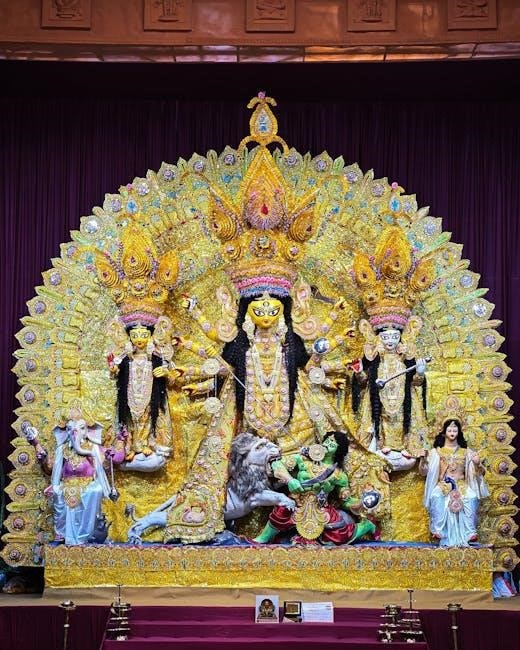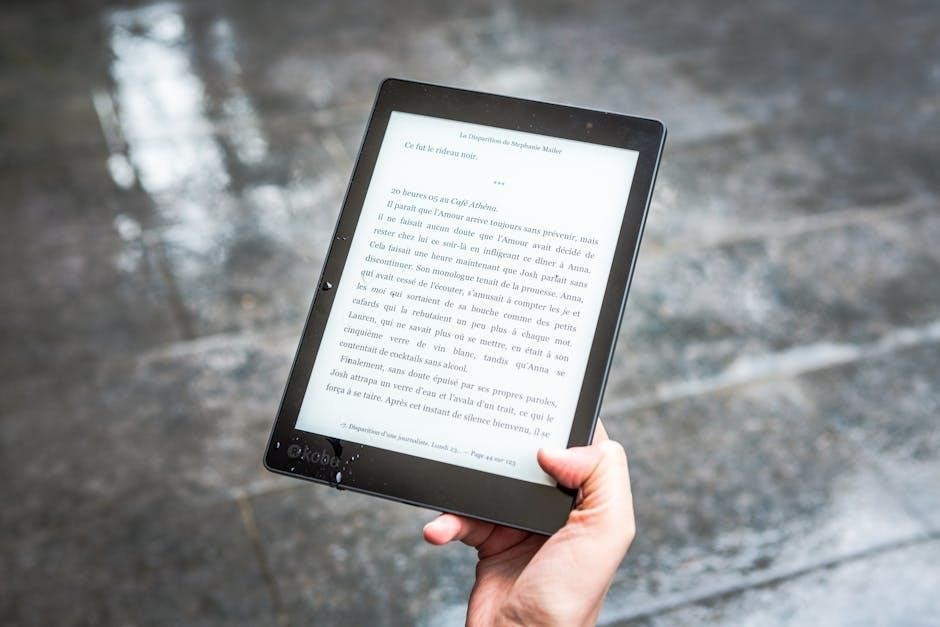The Return of the Gods PDF explores the resurgence of divine influence in a world where ancient deities reemerge, blending mythological narratives with contemporary human struggles․
Overview of the Book
The Return of the Gods PDF delves into a captivating narrative that intertwines ancient mythologies with modern-day dilemmas, creating a unique blend of spiritual and humanistic themes․ The book explores the resurgence of divine beings in a world grappling with existential crises, offering a fresh perspective on the balance between fate and free will․ Through its elaborate storytelling, the author examines the eternal conflict between good and evil, weaving intricate characters and plotlines that keep readers engaged․ The text also incorporates historical and cultural references, enriching its depth and relevance․ This thought-provoking work challenges readers to reflect on their beliefs and the role of the divine in shaping human destiny․
Written in an accessible yet profound style, The Return of the Gods PDF appeals to fans of mythology, philosophy, and contemporary fiction alike, making it a compelling read for diverse audiences․
Themes and Central Ideas
The Return of the Gods PDF centers on the themes of divine intervention, human destiny, and the eternal struggle between good and evil․ The book explores the idea of deities reemerging in a modern world, challenging humanity’s perception of faith and control over their lives․ It delves into the concept of destiny versus free will, questioning whether human choices truly shape outcomes or if they are predetermined by higher forces․
The narrative also examines the cultural and historical significance of mythology in shaping societies․ By blending ancient myths with contemporary issues, the author creates a thought-provoking exploration of spirituality, morality, and the human condition․ This blend of timeless themes and modern dilemmas makes the book a compelling read for those interested in philosophical and mythological storytelling․

Plot Overview
The Return of the Gods PDF follows the resurgence of ancient deities in a modern world, weaving mythological narratives with human conflicts and transformations, exploring divine influence and destiny․
The Return of the Gods PDF begins with the mysterious reappearance of ancient deities in a modern world, sparking both awe and fear among humanity․ The narrative opens with the gods Izanagi and Izanami, revered in ancient mythology, standing on the “bridge of heaven” and gazing over the vast ocean․ Their divine presence sets in motion a chain of events that disrupts the balance of power on Earth․ As the gods begin to reassert their influence, humanity is forced to confront its own vulnerability and the limits of its technological advancements․ The story introduces a world where mythological beings walk alongside humans, blending ancient lore with contemporary struggles․ This sets the stage for a tale of divine intervention, human resilience, and the eternal question of destiny versus free will․
The Early Chapters: Setting the Stage
The early chapters of The Return of the Gods PDF establish a rich, immersive world where ancient myths and modern society collide․ The narrative introduces the deities Izanagi and Izanami, who are central to the story, and delves into their divine origins․ These chapters also explore the initial reactions of humanity to the gods’ return, ranging from reverence to fear․ The setting is vividly described, blending mystical landscapes with familiar contemporary backdrops․ The early stages of the book focus on building tension and anticipation, hinting at the profound changes the gods’ presence will bring․ Themes of power, belief, and transformation are introduced, laying the groundwork for the conflicts and revelations that follow․ The pacing is deliberate, allowing readers to absorb the complexities of the world and its characters before the story accelerates․
The Middle of the Book: Rising Action
The middle chapters of The Return of the Gods PDF intensify the narrative, delving deeper into the conflicts sparked by the gods’ reappearance․ Izanagi and Izanami’s actions become central to the plot, as their divine influence begins to reshape the world․ Humanity’s response grows more divided, with some embracing the gods as saviors while others fear their power․ The story introduces mortal characters who find themselves entangled in the gods’ agendas, adding layers of personal struggle and sacrifice․ Mythical elements intertwine with modern dilemmas, creating a dynamic interplay between ancient and contemporary themes․ Tensions rise as the gods’ true intentions remain ambiguous, leaving readers questioning whether their return is a blessing or a curse․ The pacing quickens, setting the stage for a dramatic climax that will determine the fate of both mortals and deities alike․
The Climax: Turning Point
The climax of The Return of the Gods PDF unfolds as the divine conflict reaches its peak, with Izanagi and Izanami’s rivalry escalating into a cataclysmic event․ Mortal characters, now deeply entwined in the gods’ affairs, face a pivotal decision that will determine the world’s fate․ The gods’ true intentions are revealed, exposing a deeply conflicted agenda that blurs the lines between benevolence and domination․ Tensions between mortals and deities reach a breaking point, culminating in a dramatic confrontation that reshapes the narrative․ The climax introduces a shocking twist, as the gods’ actions provoke unintended consequences, forcing humanity to confront the reality of their existence․ This turning point sets the stage for a resolution that will forever alter the balance between the divine and the mortal realms, leaving readers on the edge of their seats․
Resolution and Ending
The resolution of The Return of the Gods PDF brings a dramatic conclusion to the divine conflict, as the balance between mortals and gods is reestablished․ Following the climactic confrontation, the deities retreat from the mortal realm, leaving humanity to grapple with the aftermath․ The world is forever changed, with remnants of divine influence lingering in the form of newfound abilities and altered landscapes․ Mortal characters, now wiser and more resilient, emerge as catalysts for a new era of coexistence․ The ending highlights themes of sacrifice, redemption, and the enduring resilience of humanity․ While the gods’ return fades into legend, the lessons learned and bonds forged during their time on Earth pave the way for a hopeful future․ The narrative concludes on a reflective note, leaving readers to ponder the intricate dance between destiny and free will․

Character Analysis

The book delves into the complexities of its characters, exploring their moral dilemmas, growth, and the profound impact of divine forces on their humanity and choices․
Main Characters: Roles and Development
The main characters in The Return of the Gods are intricately crafted to embody the central themes of the narrative․ The protagonist, a deeply flawed yet resilient individual, undergoes significant transformation as they navigate the clash between ancient divine forces and modern humanity․ Their journey from skepticism to belief serves as the emotional backbone of the story․ The divine beings, portrayed as powerful yet enigmatic figures, are central to the plot, each with distinct motivations that shape the protagonist’s path․ These characters’ interactions reveal the tension between free will and destiny, while their development underscores the book’s exploration of morality, faith, and the human condition․ Their roles are essential in driving the narrative forward, creating a rich tapestry of conflicts and resolutions that captivate readers․
Supporting Characters: Their Impact on the Plot
The supporting characters in The Return of the Gods play pivotal roles in shaping the narrative and advancing the plot․ They often serve as catalysts for the protagonist’s growth and decision-making․ Some characters provide crucial insights or guidance, while others introduce conflicts that test the protagonist’s resolve․ These secondary figures are well-crafted to complement the main storyline, adding depth and complexity to the overarching themes․ Their interactions with the protagonist reveal hidden truths about the divine world and humanity’s place within it․ Additionally, certain supporting characters embody moral dilemmas or act as foils to the protagonist, further enriching the story’s emotional and philosophical layers․ Their contributions ensure that the plot remains engaging and thought-provoking, aligning with the book’s exploration of destiny, faith, and human resilience․
Antagonists: Motivations and Conflicts
The antagonists in The Return of the Gods are driven by complex motivations that fuel the central conflicts of the story․ Many of these characters are divine beings or powerful figures who seek to assert their dominance over humanity or challenge the protagonist’s mission․ Their actions are often rooted in a desire for control, revenge, or a twisted sense of justice․ These antagonists create significant obstacles for the protagonist, forcing them to confront moral dilemmas and existential questions․ The conflicts they instigate not only drive the plot forward but also reveal deeper truths about the nature of power and the divine․ Their presence adds layers of tension and unpredictability, making the narrative compelling and thought-provoking․ The antagonists’ motivations are multifaceted, ensuring that their roles are both memorable and integral to the story’s progression․

Themes and Symbolism
The book explores deep themes of divine intervention, human fate, and the clash of ancient beliefs with modern society, rich in symbolic imagery and profound philosophical questions․
Religious and Mythological Symbolism
The book is rich in religious and mythological symbolism, drawing heavily from ancient myths and divine narratives․ The author uses deities, rituals, and sacred objects to convey deeper truths about human existence and the cosmos․ These symbols serve as metaphors for universal themes such as redemption, sacrifice, and the divine-human connection․ The portrayal of gods and goddesses from various pantheons highlights the timeless struggle between order and chaos․ The narrative weaves together mythological tales with modern contexts, creating a bridge between the sacred and the mundane․ This blend of religious imagery and philosophical inquiry invites readers to reflect on their own beliefs and the role of the divine in their lives․ The symbolism not only enriches the plot but also deepens the emotional and intellectual resonance of the story․
The Struggle Between Good and Evil
The book delves deeply into the eternal conflict between good and evil, presenting it as a multifaceted and nuanced theme․ The narrative explores how these opposing forces shape the characters’ choices and destinies․ Good is often represented through acts of selflessness, compassion, and the pursuit of justice, while evil manifests as ambition, deceit, and the desire for power․ The struggle is not merely external but also internal, as characters grapple with their own moral dilemmas․ The author highlights the gray areas between these extremes, showing how even noble intentions can lead to darkness and how redemption is possible for those who have faltered․ This duality serves as a reflection of the human condition, inviting readers to ponder their own moral compass and the consequences of their choices․
The Concept of Destiny and Free Will
The interplay between destiny and free will is a central theme in The Return of the Gods PDF, as characters navigate preordained paths and personal choices․ The book explores whether individuals can shape their own futures or if their lives are governed by a higher, inevitable plan․ This tension is evident in the protagonist’s journey, where divine prophecies intersect with pivotal decisions that alter the course of events․ The author suggests that while destiny may set the stage, it is the characters’ free will that determines the outcome․ This duality raises profound questions about the nature of control and the human condition․ The narrative ultimately posits that true power lies in the ability to choose, even when faced with seemingly insurmountable fate․ This philosophical debate adds depth to the story, inviting readers to reflect on their own lives and the forces that guide them․

Cultural and Historical Context
The Return of the Gods PDF is set against a rich cultural tapestry, blending ancient myths with historical references, creating a vivid and immersive narrative experience․
Use of Mythology in the Narrative
The Return of the Gods PDF intricately weaves mythology into its narrative, drawing from diverse cultural traditions․ The author seamlessly integrates mythological figures, themes, and symbols, creating a layered story that resonates with readers familiar with ancient myths․ Greek, Roman, and Norse mythologies are prominently featured, with deities and legendary creatures playing pivotal roles․ The narrative often reimagines classic myths in contemporary contexts, blending the timeless with the modern․ This approach not only enriches the plot but also invites readers to reflect on the enduring relevance of mythological themes․ The interplay between myth and reality is central to the story, offering a fresh perspective on age-old tales while maintaining their emotional and intellectual depth․ This fusion of mythology and fiction captivates audiences, making the book a compelling read for fans of both genres․
Historical Allusions and References
The Return of the Gods PDF is rich with historical allusions, drawing parallels between ancient civilizations and modern society․ The narrative incorporates references to historical events, such as the rise and fall of empires, and the evolution of religious practices․ These allusions serve to underscore the timeless nature of human struggles and aspirations․ The author weaves in historical figures and cultural movements, creating a sense of continuity between the past and present․ For instance, the book references ancient battles, philosophical debates, and societal transformations, which mirror contemporary challenges․ These references not only add depth to the story but also invite readers to reflect on the cyclical nature of history․ By blending historical facts with fiction, the author crafts a narrative that feels both grounded and imaginative, offering a unique perspective on the interconnectedness of time and human experience․ This approach enhances the book’s thematic resonance and intellectual appeal․
Blending Ancient and Modern Elements
The Return of the Gods PDF masterfully blends ancient and modern elements, creating a narrative that bridges the gap between timeless myths and contemporary life․ The book integrates age-old mythological concepts with modern-day societal issues, technological advancements, and cultural shifts․ This fusion allows readers to connect with the story on multiple levels, experiencing the familiarity of ancient myths while grappling with relatable modern dilemmas․ The author seamlessly weaves together archaic beliefs and contemporary perspectives, creating a unique reading experience․ This blend not only enhances the story’s depth but also highlights the enduring relevance of mythological themes in today’s world․ By juxtaposing the sacred and the secular, the book offers a fresh take on traditional narratives, making them accessible and engaging for a modern audience while preserving their original essence and significance․

Author’s Background and Style
The author of The Return of the Gods PDF is known for their deep exploration of mythology and philosophy, blending academic rigor with engaging storytelling techniques․

Biography of the Author
The author of The Return of the Gods PDF is C․ R․ Mills, a renowned writer known for his unique blend of fantasy, theology, and classical literature․ Mills holds degrees in theology and classical studies, which deeply influence his writing․ His work often explores the intersection of mythology and Christian themes, creating a rich, immersive narrative․ Before becoming a full-time author, Mills worked as a lecturer and researcher, which shaped his meticulous approach to storytelling․ He is also the founder of Everlasting Press, a publishing house dedicated to works that explore the deeper meanings of mythology and faith․ Mills’ background in both theology and literature gives his writing a distinctive depth, blending scholarly insight with engaging storytelling․ His mission is to inspire readers to reflect on timeless truths through compelling narratives․
Writing Style and Techniques
C․ R․ Mills’ writing style in The Return of the Gods PDF is characterized by a masterful blend of lyrical prose, theological depth, and narrative suspense․ His ability to weave intricate mythological and religious themes into a cohesive story is a hallmark of his craft․ Mills employs a unique dialogue-driven approach, allowing characters to express complex ideas naturally․ His descriptive language paints vivid imagery, immersing readers in a world where ancient myths collide with modern realities․ The author’s use of foreshadowing and symbolic motifs enhances the narrative’s layers, inviting readers to explore deeper meanings․ Mills’ writing is both accessible and intellectually stimulating, making the book appealing to a wide audience․ His meticulous attention to detail and thematic consistency ensure a compelling and thought-provoking read․
Research and Inspiration Behind the Book
The creation of The Return of the Gods PDF was heavily influenced by C․ R․ Mills’ extensive research into ancient mythologies, religious texts, and philosophical traditions․ Mills delved into the symbolism and narratives of various cultures, drawing parallels between their belief systems and contemporary societal challenges․ His inspiration also stemmed from historical events and timeless human questions about existence, morality, and the divine; By blending these diverse sources, Mills crafted a narrative that resonates universally while maintaining a unique voice․ The depth of his research ensures that the book is both intellectually stimulating and emotionally engaging, offering readers a rich tapestry of ideas to explore․

Reception and Impact
The Return of the Gods PDF has captivated readers globally, sparking debates about faith, power, and humanity․ Its unique blend of mythology and modern themes has left a lasting impression․
Popular Reception and Reviews
The release of The Return of the Gods PDF has garnered significant attention, with readers praising its thought-provoking narrative and profound exploration of mythological themes․ Many have described the book as a compelling blend of ancient myths and contemporary storytelling, resonating with audiences seeking deeper cultural and philosophical insights․ The PDF version has been particularly popular, making the book accessible to a global audience․ While some readers have noted the complexity of the themes as challenging, the overall reception has been positive, with many highlighting the author’s ability to weave intricate stories and evoke emotional connections․ Critics have also lauded the book’s ability to spark meaningful discussions about faith, power, and humanity․ Despite mixed opinions on pacing, the book remains a standout in its genre, leaving a lasting impact on readers worldwide․
Academic and Critical Analysis

Scholars and critics have offered a mixed yet insightful perspective on The Return of the Gods PDF, praising its ambitious exploration of mythological and philosophical themes․ Many academics commend the book for its meticulous integration of historical and religious narratives, which provides a rich foundation for analyzing cultural evolution․ The PDF format has also been noted for its accessibility, allowing researchers to easily reference and cite key passages․ Some critics, however, argue that the book’s dense symbolism and complex storytelling may alienate casual readers․ Despite this, the work is widely regarded as a significant contribution to the genre, fostering discussions on themes such as destiny, free will, and the interplay of ancient and modern belief systems․ Its impact on contemporary literature and theology continues to be a subject of scholarly debate and exploration․
Influence on the Genre and Readers
The Return of the Gods PDF has left a profound impact on both the literary genre and its readership․ By blending ancient mythologies with contemporary storytelling, the book has inspired a new wave of authors to explore similar themes, revitalizing the fantasy and philosophical fiction genres․ Readers have praised the PDF for its accessibility, allowing a broader audience to engage with complex mythological concepts․ The narrative’s universal appeal has also sparked discussions among book clubs and online communities, fostering a deeper appreciation for mythological storytelling․ Its influence extends beyond literature, as fans have begun exploring historical and religious texts referenced in the book․ This cultural ripple effect highlights the PDF’s role in bridging the gap between ancient traditions and modern readers, ensuring its lasting relevance in the literary world․
